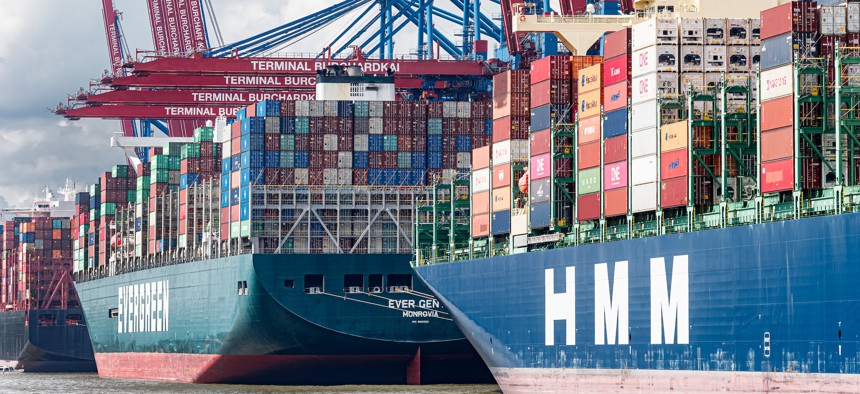
Container ships are moored for loading and unloading at the Burchardtkai terminal in the Port of Hamburg, June 10, 2022. picture alliance via Getty Images / Markus Scholz
New NATO Strategic Concept Will Broaden Vision of Deterrence
An interconnected era requires looking at security through economic, technological, and logistics lenses.
The new NATO Strategic Concept set to be unveiled later this month will press alliance members to envision deterrence as a matter not just of tanks and bombs but of supply chain security, cyberattacks, climate change, innovation, and more.
“The strategic concept needs to be able to live for the next decade, so it looks far beyond the current crisis in Ukraine. It looks at the implications for our security of…climate change, innovation, the use of…hybrid warfare, cyber war and the role of cyber in our societies. But also resilience. How resilient are our Western societies to these kind of attacks and what do we need to do in order to tackle that?” David van Weel, NATO’s assistant secretary general for emerging security challenges, said on Friday during the Defense One Tech Summit.
Much has changed since NATO’s most recent strategic concept document came out in 2010, Van Weel said. Even before Russia launched a brutal war on the alliance’s doorstep, its members had growing concern about China’s rise, its influence over emerging technology, and its outsized share of the world’s electronics supply. The new concept will reflect the fact that future threats to alliance members won’t be purely military.
“Supply chain was not an issue 10 years ago. We were still globalizing. We were working on the basis of just-in-time, just-enough logistic routes. And now we've seen with the pandemic, with the economic vision that China tends to use against countries or the fact that a simple container vessel can get stuck in the Suez Canal for two weeks, how fragile we are,” he said. “Safety and security is much more than building a border and having soldiers behind it. It's also about being able to…look after yourself and be independent.”
While the strategic concept will bring new emphasis to non-military threats, it won’t short-change military deterrence, a need dramatically demonstrated by the ongoing Russian war on Ukraine.
“I don't think it's either/or. We see now in Ukraine that what they need, mostly, now in order to stop the advancements of Russia in the Donbas is heavy artillery. And I think many people would have said two years ago that heavy artillery is probably not something we'll see in a conflict in the near future in Europe,” Van Weel said. “So we shouldn't be quickly drawing conclusions on what means are obsolete, or needed. But I think it is safe to say that in addition to that classical military deterrence and defense, there is an aspect to deterrence and defense that needs to take into account all these other [things] whether they are in energy supplies, supply chains, cyber, or in innovation and technology that can be used against us.
“I'm pretty confident that all these aspects will feature prominently in the new strategic concept.”





